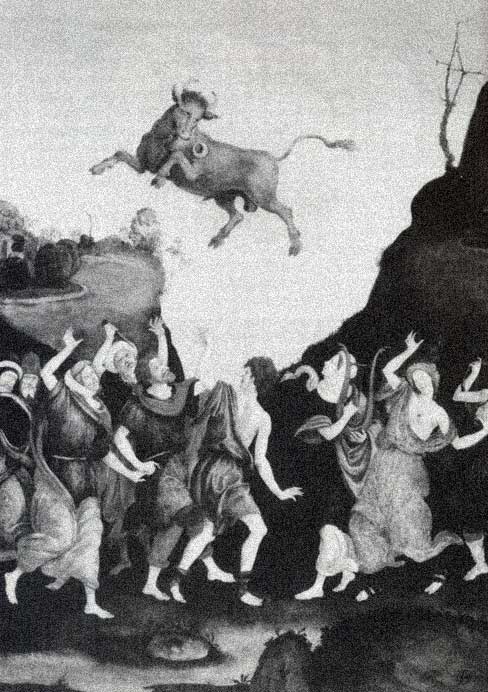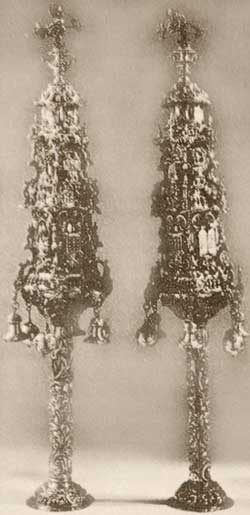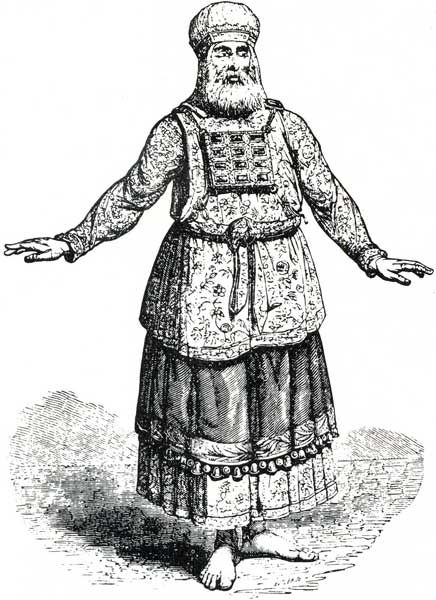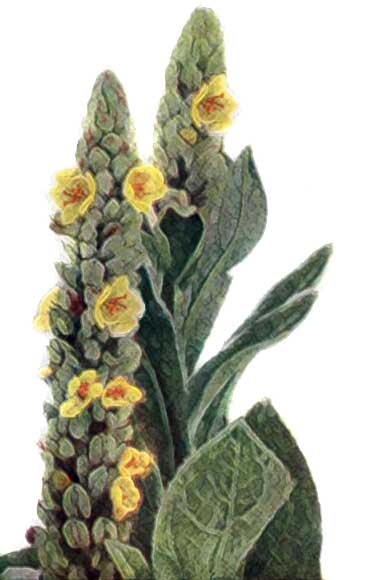Aaron, pronounced AIR-uhn (Hebrew, deriviation uncertain, a word meaning "bearer of martyrs" in Hebrew (perhaps related to the Egyptian "Aha Rw," "Warrior Lion"). Born in Egypt around 1600 B.C. and brother to the Biblical Moses and brother of Miriam, and chosen as Israel's first high priest. Geneaology suggests the father of Aaron, Amram belonged among descendants of Kohath, the son of Levi. At the time of the Exodus, the Kohathites numbered 8,600 (Num. 3:28) and makes it probable Amram, Izhar and Uzziel (Ex. 6:20ff.) were descendants of the men of like name, in v. 18, with a considerable, though unidicated, interval of time between them (cf. Lv. 10:4), though the remarkable longevity attributed to Levi (137 years), Kohath (133 years) and Amram (137 years) might provide a considerable bearing on this problem.
Second to Moses, Aaron is the most important figure in the Pentateuch. At Mount Sanai, Moses and Joshua ascend the mount to receive the Tables of the Law, while Aaron and Hur remained behind in charge over the Israelites. In Moses' absence, the people made demand for for a god to worship and Aaron was induced to participate. The making of the golden calf was to represent the deity, thereby incurring Jehovah's wrath, for which Aaron only received pardon by Moses interceding. Upon return,Moses smashed the stone tablets he was carrying. He destroyed the calf of gold, upbraiding Aaron, who replied defensively: 'Let not the anger of my lord burn hot; you know the people, that they are set on evil.' (Ex. 32:22)

The Worship of the Golden Calf, Filippino Lippi (1457-1504)
It was following those events that the Ark of the Covenant and tabernacle were constructed, and Aaron and his sons ordained as priests. Two hundred and fifty of the Israelites, led by the Levite Korah, arose in revolt against Moses and Aaron, claiming all in the congregation were holy. The earth was split open and the mutinous group swallowed.
Aaron played no part in the construction of the Tabernacle, Ark or the sacred vessels. Everything, including the vestments of Aaron and his sons wore, were made by Bezaleel of Judah and Aholiab of Dan (Ex. 31: 1-6) and the willing of the people (Ex. 35:21-35).
Aaron and the Priesthood
Aaron is never mentioned by any of the prophets, except Micah (vi:4), though his name appears often in the Psalms. Earlier Biblical traditions view Aaron as a prophet and as Moses' helper. Later traditions however, regard him as the first high priest of Israel. Generally, scholars maintain the opinion the earlier traditions about the Exodus, as reflected in the J and E documents, give Aaron a minor role, and do not make reference to him in a priestly function. A professional priesthood came into being in Jerusalem under the monarchy, and was centered on the Temple. Two orders of Priests were developed, and both claiming descent from Aaron's sons -- the Zadokites, through Eleazar, and the Aaronites, through Ithamar. Under influence of Ezra's reforms, the Zadokites became the dominant priesthood, and the Aaronites were relegated to servitude in the temple and lesser country priests. The special role of priesthood and details surrounding temple worship were elaborated in the P (priestly) document, in the post-exilic period, about the fourth century B.C. It is primarily from this late source that such themes were injected into the Books of Exodus, Leviticus and Numbers. Aaron's importance as the first high priest, and founder of priesthood was thereby magnified in retrospect.
There were three ceremonial rituals: washing, clothing, and anointing. When the tabernacle was complete, Aaron and his sons were sanctified by washing, clothed in official garments, and anointed with oil; (cf Ex 28; 40:12-15; Lv. 8) Aaron thus became the first high priest and served nearly 40 years. All priests were provided special garments, but those of Aaron were even more distinctive (Ex. 28:2). A girdle and breastplate in which was inscribed the names of the twelve tribes of Israel, (Ex. 28:9,10,21,29); and in the breastplate, a pouch of Urim and Thummin, used to ascertain the will of God in some matters (v. 30). Additionally, a turban with a plate of gold inscribed, "Holy to the Lord." Aaron was chief mediator between Israel and God. All priests were anointed with oil, but the anointing of Aaron and his sons differed from ordinary priests (Ex. 29:7, 40:12-15; Lv. 8:12). Because priesthood was hereditary, all subsequent priests had to trace their ancestry to Aaron and the Levites (cf. Nm. 3:4). In contrast to the strong emphasis placed upon Aaron's garb, nothing is said about what clothed Moses; and Moses had no successors.
Due to Aaron's role as high priest and intermediator, the New Testament reflects upon him as prefiguring the Messiah. Jesus Christ was appointed high priest (Heb. 3:1,2) in the likeness God chose Aaron (Heb. 5:1-4), though described as a greater high priest than Aaron (Heb. 7:11-28). The author of Hebrews may have had Aaron in mind when writing, "the law appoints men in their weakness as high priests," in contrast with the son of God, "who has been made perfect for ever" (Heb. 7:28).
In the books of Exodus, Leviticus, and Numbers, Aaron was both spokesman and assistant to Moses during the Israelites' exodus from Egypt, and battle with Amalekites (Ex. 17). Hur and Aaron held up Moses' hands while he prayed for victory. Aaron originally may have played an independent role apart from Moses in the deliverance from Egyptian bondage. Aaron was three years older than Moses and was eighty-three when the pharoah was first confronted (Ex. 7:7). Miriam (Nm. 26:59) was the eldest child, old enough to have carried messages when Moses was yet and infant and found by the daughter of Pharoah (Ex. 2:1-9). Aaron's mother was Jochebed, meaning "Jehovah is Glorious", which is unusual to find names combined with Jehovah in this early period. His father was Amram, a descendent of the tribal family of Kohath, of the tribe of Levi. (Ex. 6:18-20). Aaron and his wife Elisheba had four sons (Ex. 6:18-20), who followed him into the Priesthood (Lv. 1:5). Two sons, Nadab and Abihu transgressed by performing an act of sacriledge while burning incense, and were burned to death. (Lv. 10:1-5). The priesthood then passed to the remaining sons, Eleazar and Ithamar, whom at times also failed to carry out God's instructions (Lv. 10:6-20). This priesthood grew in importance in Jerusalem after the Israelites returned from exile in 538 B.C.

Torah Finials
Reminder of the bells which adorned the skirt of the High Priest. Venetian, 17th century.
Aaron represented the Jewish people as an intermediator before God. His duties were to care after the Temple and sanctuary and all its services. He was also chief of the Sanhedrin, the highest governing council of the Jews. When Aaron became high priest, he was anointed with holy oil as a symbol of authority. There were special rules for conduct of a high priest (Leviticus 21). For example, he was permitted only to marry a virgin of Israel. In earlier times, a high priest served for life, though under Herod, the Romans appointed and dismissed high priests as they saw fit.

Jewish High Priest
His official garb included a blue robe, partially covered with an ephod, or embroidered garment. He wore a linen turban called a miter on his head and a golden breastplate set with twelve precious stones that bore all twelve names of the tribes of Israel. Only the high priest was permitted entrance into the Holy of Holies, upon which he wore a white linen robe.

Early 18th century Dutch oak statue representing a high priest, Aaron is the traditional founder of the priesthood.
For doubts that God would provide for the Hebrews (Num 20:12), both Moses and Aaron were denied entry into Canaan and Aaron died on Mount Hor on the border of the land of Edom, at the age of 123, and his office then given to Eleazar. Moses died later in Moab. Aaron's death is given two accounts. The principal one gives a detailed statement to the effect that, soon after the above incident, Aaron, with his son Eleazar and Moses, ascended Mount Hor. There Moses stripped him (Aaron) of his priestly garments, and transferred them to Eleazar. Aaron died, aged 123, on the summit of the mountain, and the people mourned for him thirty days. The other account is found in Deuteronomy 10:6, where Moses is reported as saying that Aaron died at Mosera and was buried there. Some scholars think that Mosera is not on Mount Hor, since the itinerary in Numbers 33:31-37 records seven stages between Moseroth (thought by some to be Mosera) and Mount Hor.
Events of Aaron's Life
The Israelites were slaves at the beginning of Aaron's life. His brother was raised as an Egyptian by one of pharoah's daughters. Moses fled into the Midian desert after murdering an Egyptian taskmaster (Ex. 1,2). When God commanded Moses to return as a liberator of Israel (Ex. 3,4), he also sent Aaron to meet Moses in the desert (Ex 4:27). Moses was a stranger to the Hebrews after so many years in exile, so Aaron made contact with the Hebrew elders for him (Ex. 4:29-31). When Moses and Aaron went before the pharoah, God told the Egyptian monarch through them to "let my people go" (Ex. 5:1). Thus, Pharoah made life only more miserable for the Hebrews. God revealed his power to the pharoah through miracles (Ex. 5-12). The first three miracles were performed through Aaron, using a rod. The pharoah's sorcerers performed similar tricks. Afterwards, God delivers up a plague of lice, to which the Egyptian magicians declare, "This is the finger of God" (Ex. 8:19). God then creates more plagues, through Moses, culminating in the death of the Egyptians' firstborn. Aaron was with Moses (Ex. 12:1-28) when God imparts how he will "pass over" the homes of the Israelites with proper marking, sparing their children in contrast to the Egyptians. That event was the origin for the Passover feast still observed by the Jewish people (Ex. 13:1-16).
In the Qur'an Aaron is known as Harun, which is Arabic for Aaron. A significant difference in the Quran is the fact that Aaron was not involved with the creation of the Golden Calf.
References
- Charles L. Feinberg, Baker Encyclopedia of the Bible, ©1988
- Carole R. Fontaine, Ph.D., Professor of Hebrew Scriptures, Andover Newton Theological School, World Book Encyclopedia, ©2002
- Colliers Encyclopedia, ©1960
- O.T. Allis, Pictorial Encyclopedia of the Bible, Zondervan ©1975-1976
- Funk and Wagnalls Encyclopedia, ©1950
- Who's Who In The Bible, The Old Testament and the Apocrypha, Comay and Brownrigg, ©1971
- Nelson's New Illustrated Bible Dictionary, ©1995
- The New Unger's Bible Dictionary, ©1957-1988
Aaron's Rod, Architecture
- Any of several tall plants with long, flower-bearing main stems, especially a kind of goldenrod.
- In the Bible the rod with which Aaron performed miracles. It turned into a serpent. Exodus 7:10. Later it blossomed and bore almonds. Numbers 17:8.
- An architectural ornament consisting of a rod with leaves sprouting on either side, or of a rod with a snake twined around it.
-World Book Encyclopedia, ©2002
In architecture, ornament that consists of rodlike molding decorated with leaflike or scroll work or with a single serpent twined around it. Funk and Wagnalls Encyclopedia, 1950, paraphrased

Aaron's Rod, as in architecture, a single serpent twined around the object.

Aaron's Rod, as in architecture, molding
Aaron's Rod Botany
- Any of several tall plants with long, flower-bearing main stems, especially a kind of goldenrod.
- In the Bible the rod with which Aaron performed miracles. It turned into a serpent. Exodus 7:10. Later it blossomed and bore almonds. Numbers 17:8.
- An architectural ornament consisting of a rod with leaves sprouting on either side, or of a rod with a snake twined around it.
World Book Encyclopedia, ©2002
In botany, Aaron's Rod is a name sometimes attributed to the tall Mullein variety of flower, which has long, narrow flower spikes, such as the common mullein or great mullein Verbascum thapsus, and some of the goldenrods Solidago. The orpine, or live-forever, Sedum telephium, is also known as Aaron's Rod. Colliers Encyclopedia ©1960 and Funk and Wagnalls Encyclopedia, ©1950, paraphrased

Aaron's Rod, Muellin, Verbascum thapsus
Synonyms for Aaron's Rod: Mullein, Aarons Rod, Great Mullein, velvet plant, white mullein, verbascum flowers, woolen blanket herb, bullock's lungwort, flannel flower, shepherd's club, hare's beard, pig taper, cow's lungwort


No comments:
Post a Comment